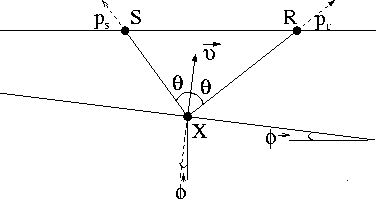




Next: Seismic wave propagation
Up: Migration in complex areas
Previous: Surface-related domains: shot and
In complex areas, it is clear that we need to operate in a different
domain, one that is related to the subsurface.
Several authors have suggested angle-domain imaging as a
solution for the reflector ambiguity (, , ).
This subsurface-related domain has many benefits. Since we are dealing
with the model itself through the reflection angles rather than some
approximation in surface-related coordinates, we are more likely to be
able to get accurate rock properties. For example, amplitude variation
with angle (AVA) analysis is more likely to be reliable than amplitude
variation with offset (AVO) analysis. Velocity analysis in the reflection
angle domain produces better velocity models and multiple arrivals can also be
dealt with well (). Additionally, I will argue
below that an event in an angle section uniquely determines a ray couple,
which in turn uniquely locates the reflector. Thus imaging artifacts
due to multipathing are eliminated in this domain.
rangle2
Figure 4 Defining the angle domain.
The reflector element is completely defined by its subsurface location
3#3 and its dip vector 4#4. This reflector element will be
represented at the surface by an event element defined by s,ps,r,pr,t,
the source position, source ray parameter, receiver position,
receiver ray parameter, and two way travel time, respectively.
The connection of the reflector element to the event element comes
from the incident and reflected rays that define the opening
angle 5#5.

For this discussion of multipathing I will limit the model to 2-D; it is
similar in 3-D,
with additional considerations such as azimuth. In Figure ![[*]](http://sepwww.stanford.edu/latex2html/cross_ref_motif.gif) ,
consider a reflector element in the subsurface. This reflector element
is completely defined by its subsurface location 3#3 and
a dip vector 4#4 that is normal to the dip of the reflector
6#6 at that point. This reflector element will be
represented at the surface by an event element defined
by s,ps,r,pr,t, which
are the source position, source ray parameter, receiver position,
receiver ray parameter, and two way travel time, respectively.
The connection of the reflector element to the event element comes
from the incident and reflected rays that define the opening
angle 5#5.
,
consider a reflector element in the subsurface. This reflector element
is completely defined by its subsurface location 3#3 and
a dip vector 4#4 that is normal to the dip of the reflector
6#6 at that point. This reflector element will be
represented at the surface by an event element defined
by s,ps,r,pr,t, which
are the source position, source ray parameter, receiver position,
receiver ray parameter, and two way travel time, respectively.
The connection of the reflector element to the event element comes
from the incident and reflected rays that define the opening
angle 5#5.
Given the definition of the reflector element, event element, and
opening angle, we can state that an event in an
angle (5#5) gather cannot be duplicated by multipathing. To
do this, I assume the Traveltime Injectivity Condition ():
a pair of rays and a total (two-way) travel time determines at most one
reflector element. In that case, the event in the angle domain
is compatible with at most one reflector element (7#7).
A more rigorous discussion of the absence of multipathing in the angle
domain has been done by ().





Next: Seismic wave propagation
Up: Migration in complex areas
Previous: Surface-related domains: shot and
Stanford Exploration Project
10/31/2005

![[*]](http://sepwww.stanford.edu/latex2html/cross_ref_motif.gif)